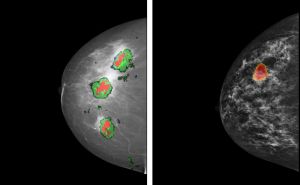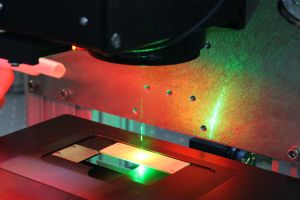Technology for mankind: Under this heading, the Gips-Schüle Foundation will grant awards for outstanding doctoral theses in mathematics, informatics, natural sciences, and engineering for the first time this year. The first prize is given to Dr. Felix Löffler, Karlsruhe Institute of Technology (KIT), for his doctoral thesis about antibody research. The second prize goes to Dr. Torsten Hopp, KIT, for his thesis on the early recognition of breast cancer.
The award granted by the Gips-Schüle Foundation, the office of which is located in Stuttgart, is intended to support research for public welfare and in particular young scientists in natural sciences and engineering. Among the criteria for winning the award are the innovation potential and the vicinity to application. The first prize is endowed with an amount of EUR 10,000, the second prize with EUR 5000, the third with EUR 2500. In total, 29 doctoral theses completed between 2012 and 2014 in Baden-Württemberg and Bavaria were proposed for the 2014 Gips-Schüle Young Scientist Award.
Dr. Felix Löffler, postdoc of the Institute of Microstructure Technology (IMT) of KIT, is granted the first prize for his doctoral thesis “Development of particle-based highly dense peptide arrays for antibody assays” written at the German Cancer Research Center (DKFZ), Heidelberg. If it was known where exactly antibodies have to bind to a pathogen for protection against an infection, it would be possible to specifically develop a vaccine or a therapy. The so-called peptide arrays play a key role for diseases like malaria or Dengue fever, for which a vaccine does not yet exist. Peptides, i.e. short protein fragments, can be applied to study binding of antibodies to proteins. Highly dense peptide arrays possess many different peptides side by side on a smallest area. With the help of these peptide arrays, proteins of a pathogen are imaged by overlapping peptides. Every field on the array contains another peptide. As the peptides are located on a very small area, a small drop of blood of a patient is sufficient to read out the binding of antibodies to all peptides simultaneously and to determine the protein regions relevant to vaccination. The working groups of Professor Frank Breitling and PD Dr. Alexander Nesterov-Müller, IMT, in which Dr. Felix Löffler participates develop new technologies to produce highly dense peptide arrays in interdisciplinary cooperation. Physicists cooperate with biologists, chemists, computer scientists, and engineers. Laser-based methods allow for the precise deposition of smallest amounts of material.
Dr. Torsten Hopp, postdoc of the Institute of Data Processing and Electronics (IPE) of KIT, wins the second prize for his doctoral thesis “Combination of X-ray mammography and 3D imaging for breast cancer diagnosis” written at the IPE. The probability of surviving breast cancer strongly depends on the time at which the tumor is detected. The standard procedure of breast imaging presently is X-ray mammography. For a more precise diagnosis, various imaging methods, such as magnetic resonance tomography (MRT), are combined with X-ray mammography. Comparison of the images recorded under different conditions, however, is very difficult. Torsten Hopp developed an automatic image registration method, by means of which two-dimensional mammograms can be compared directly with three-dimensional images produced by other methods, such as MRT or ultrasonic computer tomography (USCT). By a computer model, compression of the breast during mammography is simulated. Then, the spatial relationship of the images is represented by intuitive tools, for instance, by image correlation, i.e. the combination of information obtained from two methods in one image. The software was tested with a large number of clinical data sets and prepared for clinical use.

Image correlation: The suspicious structure of the MRT (left) or USCT (right) is superimposed on the X-ray mammogram. (Photo: Torsten Hopp, KIT)
The third prize goes to Tristan Anselm Kuder, postdoc at the German Cancer Research Center’s Division of Medical Physics in Radiology, for his doctoral thesis “Diffusion pore imaging by nuclear magnetic resonance.” This thesis lays the groundwork for a new imaging method to examine the microstructure of biological tissue, such as tumor tissue. By means of the new diffusion pore imaging method, parameters, such as the cell shape and size, can be determined. Usually, histological methods using previously taken tissue samples are applied. In the course of the work on the doctoral thesis, first measurements were made. They demonstrated the practical suitability of the method. In the future, the diffusion pore imaging method might be used for the determination of histological parameters in tumor diagnosis or for the diagnosis of lung diseases.
Program of the Gips-Schüle Young Scientist Awards Ceremony
Wednesday, October 22, 2014, 17.30 – 19.00 hrs
KIT Campus South, Building 11.30, Senatssaal
Presented by: Markus Brock
Welcome
Professor Holger Hanselka, President of KIT
Thomas Ducrée, Board of the Gips-Schüle Foundation
Hand-over of Awards and Interviews of the Winners about Their Research Work
Dr. Tristan Anselm Kuder, DKFZ (3rd prize)
Dr. Torsten Hopp, KIT (2nd prize)
Dr. Felix Löffler, KIT (1st prize)
Musical Contribution
Benoît and the Mandelbrots, Karlsruhe University of Music
Panel Discussion:
Research Policy and the Promotion of Young Scientists
Professor Peter Frankenberg, former Minister of Science of the State of Baden-Württemberg
Professor Britta Nestler, Chair for Microstructure Simulation in Materials Technology, KIT
Dr. Felix Löffler, Postdoc of the Institute of Microstructure Technology, KIT
Reception and Get-together
Activities of the Gips-Schüle Foundation based in Baden-Württemberg cover the three areas of science and research, young scientists, and education. The Foundation focuses on supporting non-profit institutions, such as universities, research institutes, or foundations. The Gips-Schüle Foundation funds endowed professorships and colloquia for doctoral students, it grants scholarships, and supports studies ambassadors who encourage secondary school graduates to start studies of mathematics, informatics, natural sciences, and engineering. Every two years, the Gips-Schüle Foundation grants the Gips-Schüle Research Award in the amount of EUR 40,000, the Special Research Award in the amount of EUR 15,000, and the Gips-Schüle Young Scientist Award in the amount of EUR 10,000. All prizes honor and support outstanding achievements in applied research for “Technology for Mankind.” More information is available at www.gips-schuele-stiftung.de.
In close partnership with society, KIT develops solutions for urgent challenges – from climate change, energy transition and sustainable use of natural resources to artificial intelligence, sovereignty and an aging population. As The University in the Helmholtz Association, KIT unites scientific excellence from insight to application-driven research under one roof – and is thus in a unique position to drive this transformation. As a University of Excellence, KIT offers its more than 10,000 employees and 22,800 students outstanding opportunities to shape a sustainable and resilient future. KIT – Science for Impact.

